When it comes to safe driving at night, upgrading the headlights in your car or truck with HID or LED bulbs can make a dramatic difference in your ability to see long distances. Dozens of articles and videos on the Internet compare the two technologies. Piecing together information from all of them and wading through the marketing hyperbole can take time. Let’s lay out the features and benefits of LED and HID lights to help you choose the solution that will work best in your vehicle.
The Fundamentals of HID Lighting Systems
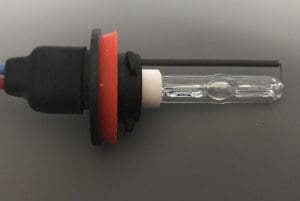 High-intensity discharge (HID) lamps operate by applying 80 to 90 volts across a quartz glass arc tube filled with xenon gas at pressures between 70 and 700 psi, depending on the design and application. The current flowing through the arc tube causes the mercury and metal halides in the bulb to ionize into plasma and produce a bright light.
High-intensity discharge (HID) lamps operate by applying 80 to 90 volts across a quartz glass arc tube filled with xenon gas at pressures between 70 and 700 psi, depending on the design and application. The current flowing through the arc tube causes the mercury and metal halides in the bulb to ionize into plasma and produce a bright light.
HID bulbs will not light (ignite) from the standard ~85V supply voltage and require an even higher voltage to begin the ionization process. An initial voltage of 15,000 to 25,000 volts is applied to the arc tube where a small amount of argon gas helps the voltage to travel from one electrode to the other and create heat. The process is similar to the way a coil pack creates a spark across spark plug electrodes to ignite the air and fuel mixture inside your engine. The heat created by the spark begins the mercury ionization process. In most applications, the ignition process takes 10 to 15 seconds. The ignition process can be made faster, but this would decrease the life of the bulb and the control ballast.
How Do LED Bulbs Work?
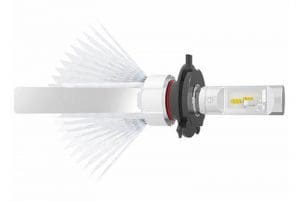 By comparison, LEDs are simpler from a mechanical perspective but more complicated in terms of chemistry. Using a process called electroluminescence, light-emitting diodes are solid-state devices that emit light when current in the form of electrons passing through the semiconductor recombines with electron holes and releases energy in the form of electrons. If you are having sporadic flashbacks to 9th- or 10th-grade chemistry class, then we’ve done our job.
By comparison, LEDs are simpler from a mechanical perspective but more complicated in terms of chemistry. Using a process called electroluminescence, light-emitting diodes are solid-state devices that emit light when current in the form of electrons passing through the semiconductor recombines with electron holes and releases energy in the form of electrons. If you are having sporadic flashbacks to 9th- or 10th-grade chemistry class, then we’ve done our job.
Unlike HID bulbs, LEDs don’t require anything special to get them started, and contrary to popular belief, both HID and LED lighting systems draw roughly the same amount of power when in operation, at about 3.0 amps per bulb.
Drawbacks of HID Bulb Upgrades
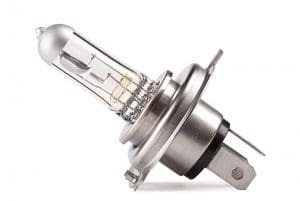 While HID bulbs are amazingly bright and efficient compared to incandescent bulbs, your installer needs to find a location to mount the starter circuitry and high voltage power supply — a device commonly referred to as a ballast. Finding a solid mounting location is critical to the long-term reliability of these components.
While HID bulbs are amazingly bright and efficient compared to incandescent bulbs, your installer needs to find a location to mount the starter circuitry and high voltage power supply — a device commonly referred to as a ballast. Finding a solid mounting location is critical to the long-term reliability of these components.
HID bulbs require up to 15 seconds to reach their full light output capability. For this reason, they are not an ideal solution for high-beam applications where you need instant light in a “flash to pass” situation.
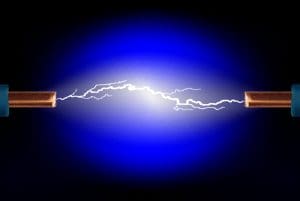 Finally, it is imperative to the long-term reliability of a HID lighting system that it be provided with adequate voltage and current during the startup process. The creation of the >15,000-volt spark can draw as much as 10 amps of current per bulb. The increasingly smaller factory wiring found in modern vehicles, along with the fact that headlights are usually left on during the engine cranking process, can make delivering the full electrical system voltage at a draw of 10 amps per ballast difficult.
Finally, it is imperative to the long-term reliability of a HID lighting system that it be provided with adequate voltage and current during the startup process. The creation of the >15,000-volt spark can draw as much as 10 amps of current per bulb. The increasingly smaller factory wiring found in modern vehicles, along with the fact that headlights are usually left on during the engine cranking process, can make delivering the full electrical system voltage at a draw of 10 amps per ballast difficult.
When wiring is undersized, you may find that one bulb doesn’t ignite when you turn on your headlights. For this reason, HID system manufacturers strongly recommend the use of a dedicated, high-quality relay harness with a HID bulb upgrade. Direct connections to the battery for power and ground, relays rated for the high starting current of the system and quality all-copper conductors will help to ensure that your ballasts function efficiently and reliably.
Drawbacks of LED Bulbs
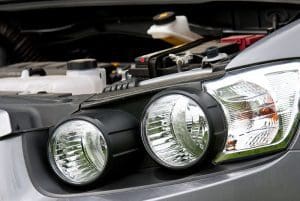 The rage over the last few years has been to use LEDs for bulb upgrades. As we mentioned earlier, LEDs reach their full output almost instantly, making them ideal for high-beam and turn signal applications. The primary problem with LEDs bulbs is managing their heat. If the LED chips on the bulb exceed about 257 degrees Fahrenheit (125 degrees Celsius), they can fail quickly. For this reason, LED bulbs include cooling fins in the form of braided copper strands or aluminum bands to help carry heat away from the LED chips. Some designs use small cooling fans. As long as the bulb is fully enclosed in a dust-proof housing, fan-cooled LED bulbs can work well.
The rage over the last few years has been to use LEDs for bulb upgrades. As we mentioned earlier, LEDs reach their full output almost instantly, making them ideal for high-beam and turn signal applications. The primary problem with LEDs bulbs is managing their heat. If the LED chips on the bulb exceed about 257 degrees Fahrenheit (125 degrees Celsius), they can fail quickly. For this reason, LED bulbs include cooling fins in the form of braided copper strands or aluminum bands to help carry heat away from the LED chips. Some designs use small cooling fans. As long as the bulb is fully enclosed in a dust-proof housing, fan-cooled LED bulbs can work well.
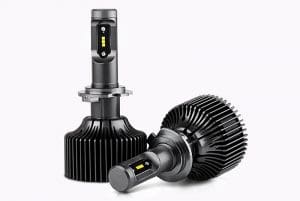 LED bulb manufacturers have a wide choice of LED chips to use in their bulb designs. The goal of the bulb design is to place a light source in the exact same position as you’d find in an incandescent bulb. The filament in an incandescent bulb is long and narrow, so the LED array should be similar in order to maintain the proper beam pattern. One problem with LED bulbs is that they don’t produce a 360-degree source of light and may require adjustment and tuning to achieve a satisfactory beam pattern.
LED bulb manufacturers have a wide choice of LED chips to use in their bulb designs. The goal of the bulb design is to place a light source in the exact same position as you’d find in an incandescent bulb. The filament in an incandescent bulb is long and narrow, so the LED array should be similar in order to maintain the proper beam pattern. One problem with LED bulbs is that they don’t produce a 360-degree source of light and may require adjustment and tuning to achieve a satisfactory beam pattern.
Is HID or LED Better?
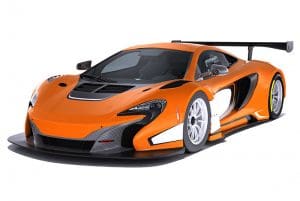 Deciding which bulb upgrade is better for your car is like trying to decide if a red Ferrari is better than an orange McLaren. They are as different as they are similar. We spoke with Chris at HIDCOR Industries, a 20-year veteran of the automotive lighting industry, about lighting upgrade options. He told us that he starts each consultation by asking the client why he or she wants to upgrade their lights. The two most common answers are for looks and for performance. If you want that classy, modern white light, then he suggests LEDs are the way to go. They are easy to install and very reliable. If long-distance vision is the goal, then Chris suggests a 4300K (OEM color) or 6000K (pure white) HID upgrade along with a dedicated wiring harness to deliver every ounce of output possible. The HID upgrade is more involved as the ballasts and harness need to be installed properly, so it might be a little more expensive once the dust settles.
Deciding which bulb upgrade is better for your car is like trying to decide if a red Ferrari is better than an orange McLaren. They are as different as they are similar. We spoke with Chris at HIDCOR Industries, a 20-year veteran of the automotive lighting industry, about lighting upgrade options. He told us that he starts each consultation by asking the client why he or she wants to upgrade their lights. The two most common answers are for looks and for performance. If you want that classy, modern white light, then he suggests LEDs are the way to go. They are easy to install and very reliable. If long-distance vision is the goal, then Chris suggests a 4300K (OEM color) or 6000K (pure white) HID upgrade along with a dedicated wiring harness to deliver every ounce of output possible. The HID upgrade is more involved as the ballasts and harness need to be installed properly, so it might be a little more expensive once the dust settles.
Chris explained his reasoning for HID over LED for long-distance lighting needs, but we’ll save that for another article at another time. In the meantime, if you are interested in improving your ability to see safely at night, drop by your local specialist mobile enhancement retailer and ask about the HID and LED bulbs that are available for your vehicle.
This article is written and produced by the team at www.BestCarAudio.com. Reproduction or use of any kind is prohibited without the express written permission of 1sixty8 media.
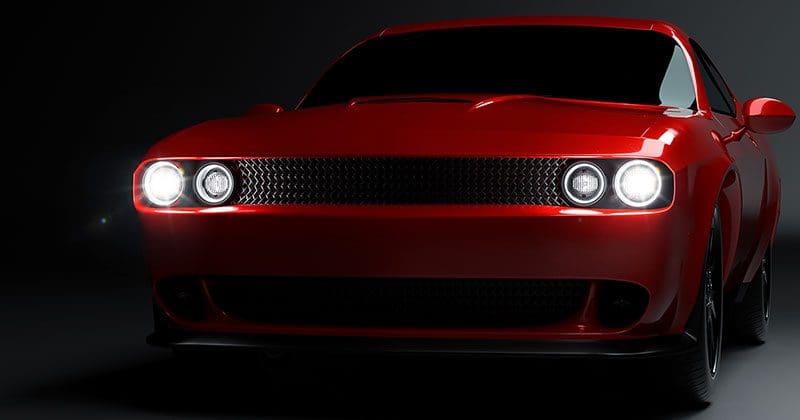

Leave a Reply